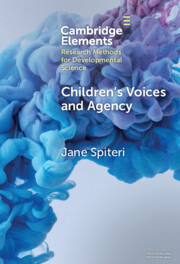Element contents
Children's Voices and Agency
Published online by Cambridge University Press: 20 September 2024
Summary
Keywords
- Type
- Element
- Information
- Online ISBN: 9781009285407Publisher: Cambridge University PressPrint publication: 17 October 2024
References
- 2
- Cited by

